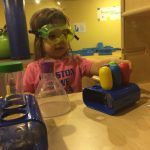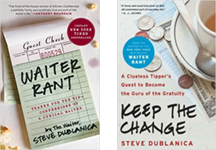My wife had a business meeting in Seattle and, having never been there myself, we decided to make it a mini-family vacation. After a tumultuous plane ride with a three-year-old, we landed in the birthplace of Starbucks.
Annie didn’t wrap up work at the convention center until 3:00 PM so I oversaw entertaining Natalie in the mornings. So, on Friday, I strapped Natalie into her stroller and carefully walked down the Seattle’s steep hills down to the Pike Street Market and bought breakfast. As I sipped my coffee I scanned my smartphone for kid friendly things to do.
“Do you want to go to the playground?” I said. “Ride the train?”
“Yep,” Natalie mumbled through a mouthful of bagel.
“Then away we go.”
Unfamiliar with the area I went old school and asked a policeman for directions. “I want to go to the playground by The Space Needle,” I said.
“She’s going to love that place,” the cop said, winking at my daughter. “Just walk over to the Westlake Center and take the elevator up to the monorail station. The Space Needle’s the only stop. You’ll see the playground as soon as you get off.”
When Natalie saw the gigantic playground from the monorail her eyes lit up with joy. “Oh wow!” she squealed delightedly. “I want to play! I want to play.” My heart, however, sank. The playground featured a massive rope climbing structure with two large slides at the top. I knew instantly that my daughter was small to climb up. I decided to let her try anyway.
As I feared, Natalie couldn’t get past the first level and rapidly became frustrated. “I want to go on the slide!” she wailed.
“I’m sorry, Natalie,” I said. “You’re too small.”
“Take me up!” she demanded. “Take me up!”
Adults were not allowed on the ropes and, even if they were, there was no way I could climb to the slides with Natalie under my arm. “Sorry, honey.” I said. “We’ll come back when you’re older.” The ensuing meltdown was predictable.
As Natalie cried in her stroller I walked around searching for a bathroom. Finding a public building, I took care of my daughter’s potty needs, cleaned her face and then tried figuring out what to do. I had hours to kill and an upset kid on my hands. Luckily, the building I was in contained the answer to my prayers – The Seattle Children’s Museum.
“That’ll be $22 dollars,” the cashier said when I asked for two tickets.
“No problem,” I said, gladly handing her my money. Whatever angst my daughter was suffering from the playground debacle evaporated the moment she ran into the museum. Whoever designed this place knew what they were doing. It’s a wonderland for small children and, if you’re ever in Seattle with little tykes, I cannot recommend it enough.
The first exhibit Natalie found was called “Cog City,” a room filled with gears and magnets, pneumatic tubes that shot ping pong balls out of a Rube Goldberg looking gizmo and a machine that levitated a plastic ball on a cushion of air. My daughter went crazy with delight and, after forty-five minutes, had to be dragged out of there.
“I want to play with the toys!” she cried. “Toys!”
“But there’s more to see, Natalie.”
“I don’t want to go!”
“Trust me, Natalie,” I said. There’s more fun around the corner.”
The next exhibit was called “Fort Adventure” a place where kids could build structures out of foam blocks and blankets, play in tee-pees and let their imaginations run wild. Natalie forgot about “Cog City” in two seconds. And, after an hour, I had to drag her our again.
“I want to play!” she cried, again. “I want to play.”
“Look!” I said, pointing to the other exhibits. “There’s a fire truck! A grocery store! A movie theatre!”
Natalie was now in kiddie Valhalla. She played grocery store with some kids, danced like a ballerina on the movie stage, pretended she was a chef in a restaurant, rode a fire truck, a bus, donned goggles and played scientist with plastic beakers and test tubes, pretended to be a doctor, a construction worker and a cave explorer. Sitting down on a bench with some other wiped out parents, I smiled as my daughter ran around laughing and shouting with joy. I had never, ever seen Natalie so happy.
Three hours ticked by and Natalie showed no signs of slowing down. “I’m hungry,” I eventually told her. “Let’s go upstairs and get something to eat.”
“No,” Natalie said.
“We’ll come right back.”
“No.”
“Oh brother,” I said to a mother sitting next to me. “I’m never getting out of here.”
“That’s the hardest part of this place,” the woman said. “Leaving.”
My wife texted to tell me she had left the convention hall and to meet her at the Pike Market. “Give me another hour,” I wrote back. “Natalie’s having a blast here.”
That’s when I began prepping Natalie to leave. “We have to meet Mommy. One more hour and then we have to go.” If Natalie heard me she gave no clue. She just played and played and played. By three o’clock I was ravenous with hunger and very tired. All I wanted was a sandwich and a cold beer but Natalie was in no mood to leave.
“We have to meet Mommy,” I said. “Let’s go. Say bye-bye.”
“NOOOOOOOOO! I WANT TO PLAY! TOYS! TOYS!”
“Sorry, Natalie,” I said, picking her up. “Time to go.”
When I finally got Natalie out of the building she was the angriest I had ever seen her. “I want to go back, Daddy. Go back!” she screamed. Then she smacked me in the face and sent my glasses flying.
Shocked, I wrestled Natalie into her stroller and belted her in. When I finished, an old woman handed me my glasses. “You lost these,” she said.
“Thank you,” I said. “I’ve never seen her like this.”
“I have grandchildren,” the old woman said, smiling. “I understand.”
“I was afraid of this,’ I said, “She was having such a good time in the museum.”
“How old is your daughter?”
“Three and a half.”
“They get like that at this age,” the woman said. “Don’t worry.”
“I know,” I said, tears suddenly stinging my eyes. “But I feel like a failure anyway.”
“This is normal stuff,” the old woman said, putting her hand on my shoulder. “And you’re not a failure. Failures don’t take their children to do fun things like the museum.”
“Thank you.” I said, grateful but surprised at my sudden vulnerability with a total stranger.
When we got back on the monorail, I knelt next to Natalie and wiped away her tears. “I’m sorry we had to go, honey,” I said. “I know you were having fun.”
“Toys,” she whimpered. “Toys.”
“Daddy loves you,” I said. “And I promise we’ll do fun things like this again. Okay?”
“Okay.”
“Do you want to watch Ben and Holly?”
“Yes, please.”
I fished my smartphone out of my pocket, fired up You Tube, and let my daughter watch her favorite children’s show. Within minutes she fell asleep but I was still felt discombobulated.
A few days ago, I read an obituary for Peter Berger, a Protestant theologian who was famous for fighting the whole “God is dead” thing back in the Sixties. He wrote that there was an “otherness which lurks behind the fragile structures of everyday life” and that one could find “signals of transcendence” in common experiences. “A mother’s reassuring a frightened child that all is well,” he wrote “suggests a confidence in a trustworthy universe,” and “A mortal’s insistence on hope in the face of approaching death implies a conviction that death may not be final.”
I think that theologian was right. Ever since I was a child I felt there was more to the world than I could see, touch and measure – that the greatest reality is hidden, lurking, as Berger said, just beneath the surface. And Natalie’s fury that her fun had to come to an end revealed something about that otherness to me. I’m almost fifty. The odds are good my death is still a long way off but, like Mount Rainer hovering over Seattle in the distance, I can see it on the horizon. I know the party is going to end but guess what? – I still want to play.
I have seen many people die. Some of them were in shock and had no idea they were slipping away, others went peacefully, and quite a few cried pitifully as Death came for them. Natalie’s upset over leaving the museum made me think about my death – that I wouldn’t want to go when the time came; that I would cry and scream, upset that I wasn’t finished playing – not wanting to leave life for some unknown place.
When that moment comes, I thought to myself, would someone carry me and whisper, “Don’t worry, there’s more to see. Trust me, there’s more fun around the corner?” Were the words I said to my own daughter a glimpse of what was waiting for me on the other side? And what about that old woman comforting me in my moment of fragility – telling me that I wasn’t a failure as a Dad? She was just being nice, but perhaps, just perhaps, she was speaking with reassurance of the ages. Maybe I caught a bit of that commonplace transcendence Berger was talking about. Who knows?
When I finally met my wife for lunch and that cold beer, I told her about our time in the museum. “Natalie was in heaven,” I said. “I felt bad for ending it.”
Nodding towards our sleeping daughter Annie said, “She’ll forget all about being upset. If she remembers anything at all, she’ll remember being happy with her Dad.”
“I hope so.”
As we ate lunch I thought about my child’s wild joy in the museum. She had fun playing, as all children should. And Berger said that there was a lesson in that too, another revelation hidden in the everyday. Laughter and play, he wrote, affirms “the triumph of all human gestures of creative beauty over the gestures of destruction.” Natalie gave me a glimpse into the bliss often hidden within the reality of earth. Sipping my beer, I remembered that the world, despite all its sorrow and pain is still a very beautiful place. There is still time for me to play.



You brought tears to my eyes .😥. Well written Love, Mom ❤️
Great essay — I still want to play, too, and everytime I read the obits in the paper and see how many people younger than I have passed on to the next playground, I realize that time is fleeting and we must be aware that NOW is the time to play.
Haven’t read you in a while, but this is exactly what I needed tonight. Thanks.
Thank you for this! At 67, the end seems to be closer than I thought, but this, dear man, has reminded me that until that last call, we still get to play! xox
Always love your stories! Thanks for the reminder on Facebook.
It’s been a long time.
Glad to see you shared some new thoughts of wisdom
You brought tears to my eyes too. Amazing. (another) Mom.
Free advice — your daughter threw that tantrum because she was overtired (as evidenced by the fact that she fell asleep within minutes of hitting the stroller). Paying attention to a small child’s sleep schedule is critical, and is the easiest way to avoid most meltdowns.
Hey Steve. You know, being an ‘old’ parent is hard. I wrestle with this every day. I’m 51 and I have an 11 year old. He’s had to deal with my cancer diagnosis, surgery and treatment at age 6; a family member’s suicide at 8; my being diagnosed with NASH at 9 and everything in between. I know that my health isn’t great and I try hard to keep myself healthy enough to make it to his 40th birthday but I also know that the damage done to my body by medications meant to save my life may cause this not to happen. We are all fragile. We all remember the times when our kids lose their shit at us rather than the joy that they were in before that. My son remembers good things and not the bad most of the time. All we can do as parents is try to be there for the ride and try to show them all the love we have for them. Natalie may never remember what happened but she will have that moment of euphoria in her soul if you try to remind her of the museum when she’s older.
Really loved the picture, you can see the happiness
Beautiful mate, made me think about ‘Rob’ over at clublife. Your two blogs are the only two I ever really got into, it’s so long ago I can’t remember which one lead me to which. : )
It really does zip by, seems like I was doing the same not so long ago. My daughter was ten in April…
When i read your comment that got me thinking, “Whatever happened to Rob the Bouncer?” So I did some poking around, and to my utter shock, learned that Rob died in 2014. He was only 44. I scrolled through my email archives and read through our correspondance back in 2005-6. Rob was an excellent writer, brutally honest and very funny. I was sad, albeit belatedly, to hear such a fine talent was taken away from us. Wherever Rob is, I hope he is still getting to play.
There’s a bunch of remembrances about him at this website .https://www.elitefts.com/news/gone-too-soon-one-last-rant/
This was beautiful! So many ideas to take away from it. I love the imagery of the all-knowing Father coaxing us kicking and screaming through the next door, seeing what we cannot, assuring us that there is more beauty to come. How comforting.
Thank you for a fine essay. Unlike Natalie — yet — many of us accept the fact that it can will someday come time to call the game, no matter how much fun it has been, because we can no longer play it. Who wants to go early — some of my friends have? And yet, who wants to stay too long, and strike out at those around us in disorientation and fatigue?
Cosmos willing, you’ll have plenty of time to play. Every day is a victory, and a chance to laugh. Which is pretty much the same thing.
BTW, you’re lucky you didn’t take her to Archie McPhee’s. She’d have melted down _and_ you would have gone broke. 😉
What a story! I couldn’t stop reading for a second there, so beauitful! Thaks for sharing this with us, really.
Well, that is a really good story. Thanks for sharing.
Thought provoking as always, Steve. From one father to another, thank you for reassurance and perspective. Always insightful, measured and prosaic, a sure-fire 20% tip to you!
She’s a spitfire, and I hope she never loses that spark. The people most worried about being good parents are usually the ones that don’t have to worry about it. I had an insane 2/3 year old and he’s grown to be a fine young 17 year old. Makes it worth all the tantrums, LOL